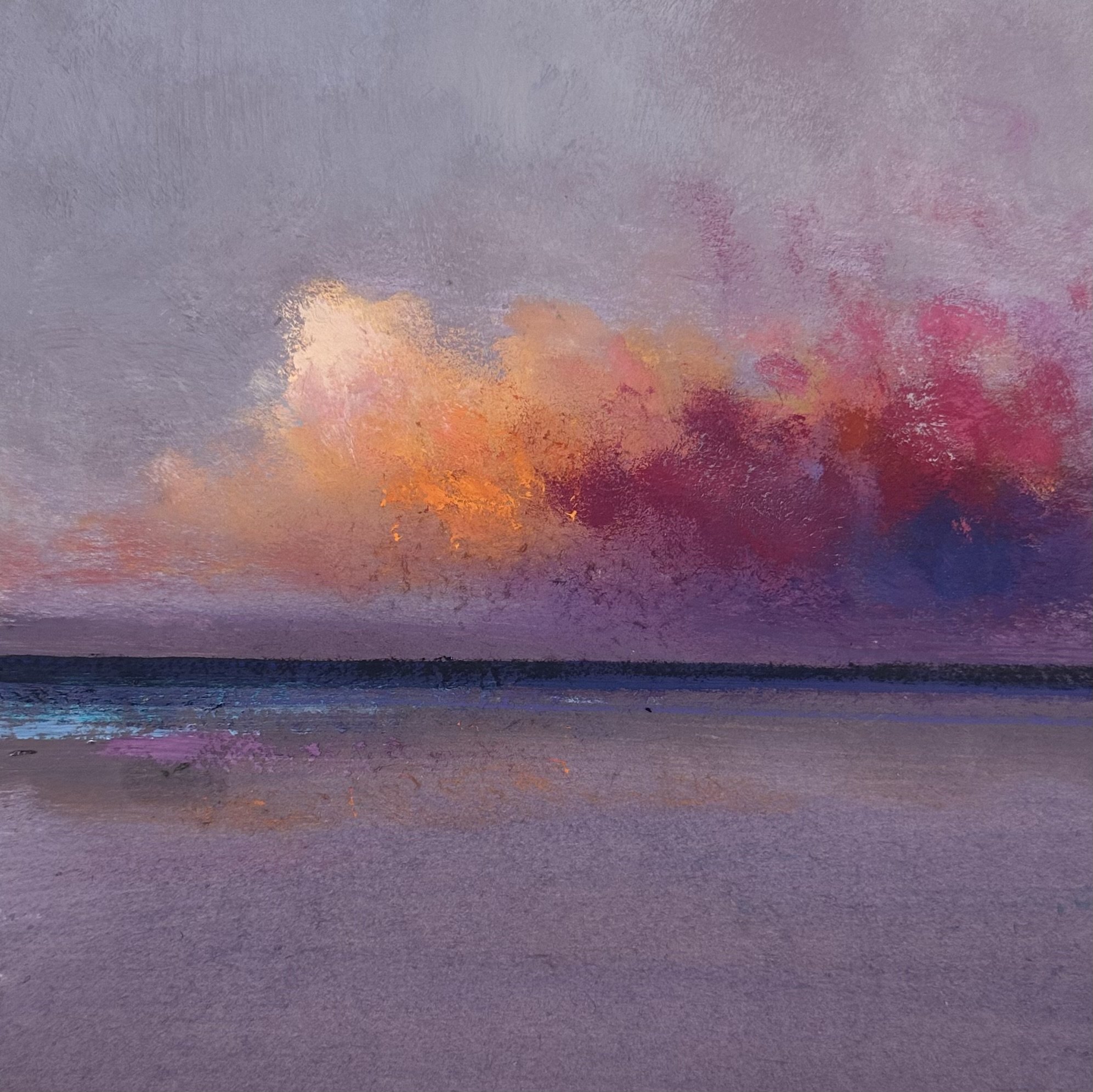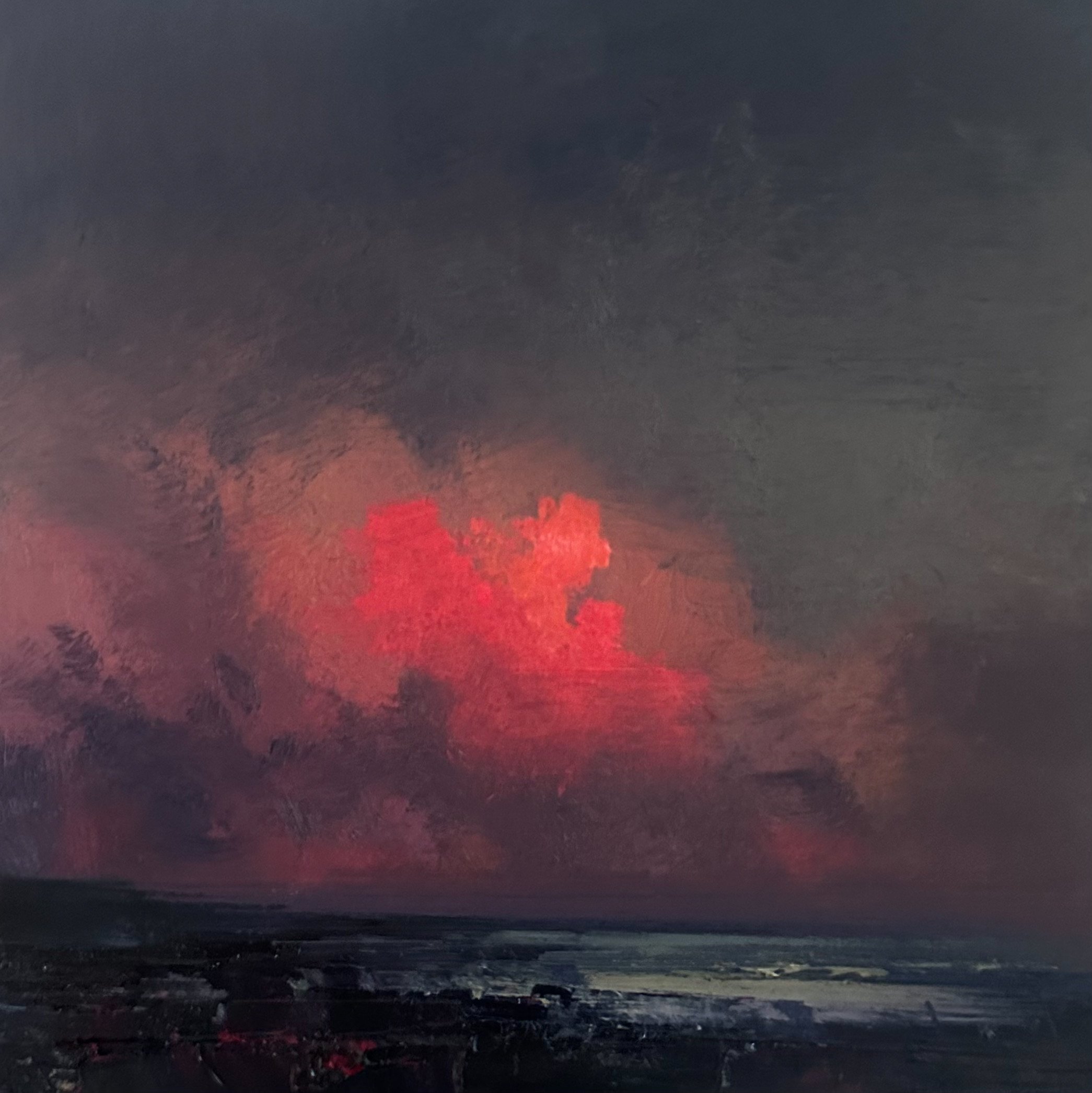Capturing the Elements with Richard Blades
Born in 1978 in the UK, Richard's artistic journey began in his mid-twenties while living in Cornwall. The expansive skies and tranquil landscapes of East Anglia (where he grew up) and now in North Norfolk (where he resides), deeply influence his work. He paints landscapes and still-lifes.
Richard draws inspiration from Impressionism, Abstract Expressionism, and the English Romantic tradition (a movement from the late 18th and early 19th centuries that emphasized emotion, nature, and the sublime). Romantic painters sought to capture the power and beauty of the natural world, evoking awe, melancholy, and transcendence. This rings true for Richard.
He feels a deep connection to the landscape, and his influences include artists like Turner, Constable, Seago, Daubigny, and Courbet, all of whom turned to the sky, sea, and land as their sources of inspiration.
Outside of painting, Richard curates exhibitions at his gallery, The Point Contemporary in Cromer UK. He also hosts painting workshops for Penn Studio School of Art and Winslow Art Center.
When I first saw Richard’s artwork, I was struck by his use of colors and ability to capture the light and shadow of sunsets so perfectly. It’s as if you can sense the movement of the wind and the ocean in the layers of paint. His artworks are distinct, yet still share the same strong narrative. Personally, I am drawn to sunsets and that magical moment before the colors fade away into the background. Each time you witness one, it feels like a new core memory being created because no two landscapes are the same. Richard captures this experience beautifully.
In the above painting entitled Friday, we see these themes at play. Broad, sweeping strokes convey the weight of the sky, while subtle textures hint at the motion of waves. It’s not just a depiction, it’s an invitation to experience it. I like that Richard’s paintings encourage viewers to pause and reflect, offering a sense of calm and introspection.
You can feel the solitude in the art as well, as if the viewer is the only one to have witnessed that event, along with the awe it evokes.
Richard’s paintings exist in the space between realism and abstraction, where atmosphere and emotion take precedence over fine detail. We feel his work will resonate with those who appreciate the subtle beauty of everyday moments and the ever-changing moods of the natural world.
We hope you enjoy his thoughtfulness in the Q&A below as he shares more about his process, how he views failure, and what the act of painting means to him.
What would you like people to know when they first come across your artworks?
It may be a cliche to say but I would like the paintings to speak for themselves – that the viewer can be in communion with the work, on their terms. Art is highly subjective and a painting will mean different things to different people, anywhere from indifference, to bemusement or absolute connection. Ultimately, when I paint, I am painting for myself to get as close to an alignment of how I experience things and how I’m able to express them.
There is another element and this is important for me, painting is also about painting. People sometimes say that they can see Turner or Rothko in my work and this is deliberate on my part. I am, in my way, trying to have a conversation with them and other artists. A shared language of sorts and if the viewer can see this, then I feel as though that conversation can be heard.
When thinking about where you are in your journey, what are you most excited about and what keeps you inspired for the future?
The journey is ever evolving and making new work always excites me. In many ways, the pressures reflect the progress I’ve made so far and there are a lot of deadlines that must be met. Navigating this, especially with the nature of creativity being so temperamental, can be a challenge. However, this tension can be at the heart of the creative process.
Sources of inspiration are finally balanced with productivity and I always try to leave a space for experimentation and trying out new ways of working. Nature is my greatest source of inspiration and it is boundless, there is always something new or different to harvest inspiration from. The seasons change, as does the light on an hour-to-hour basis.
This year I have many exhibitions and projects that I’m preparing for and excited about. My daily walks along the coast and through the woods provide the fuel for the fire that is the creative process.
If you could go to dinner with any artist, who would it be and why?
This is such a difficult choice to make, can it be a dinner party? I’m going to take liberties here and go with a small dinner party. Here are my companions: Mark Rothko, Joan Eardly, Howard Hodgkin, JMW Turner. I don’t think they’d be much fun but the creative tension would be beautiful.
What is the best piece of advice you've been given?
It was not so much advice but an example. In my early years, I had this idea that an Artist could rely on talent alone for success and that inspiration came from a kind of passive openness. And if I were to live for experience only, then the inspiration and Art would come. That this inspiration could be found through hedonism or giving oneself over to the vicissitudes of life. It was only when I started reading the biographies of Artists and studying their lives that I realised that the proverbial suffering that an artist endured was as much about a dedication to work as it was about anything else. In that sense, inspiration was found through hard work, repetition, and a stoic dedication to turning up and working things out on the canvas.
Suffering came through frustration and in many ways, a denial of the myriad other things that one could experience. The arena of inspiration and also success is the studio, both physically, emotionally but also spiritually.
What is one thing you wish you'd be asked in an interview?
How do you deal with failure? Failure is a part of the creative process. It is also part of life’s process and no matter who we are or how successful we may be, failure is an essential part of growth. The majority of my paintings have failed at one point during their creation– I lose them, they fall apart and this can be an awful feeling. Rather than walking away, I always see these failures as an opportunity to take risks and be radical in moving them forward. When all feels lost, we can step outside of the security of ourselves, of what we know works and in this, we have the chance to become a better version of ourselves. The same goes for a painting. I have always appreciated Art that reflects both the triumph and failings of the creative process. The history of a painting's surface can reflect and represent the journey it has taken.
How has your practice evolved over time?
My practice is always evolving, both visually but also philosophically. This evolution is a natural process of practice, of doing and reflecting. As much as it evolves, some things remain the same and at the heart of my creativity is a desire to align my perceptions and experiences with what I’m able to express with paint.
Over the years, I have come to understand that there is no such thing as a perfect painting. Even though I will always strive for this, time and experience have taught me that perfection is an illusion. In a way, it is a good illusion because it keeps the hunger there and keeps the artist returning to the easel. But as the acceptance of imperfection becomes stronger, the longer I paint.
In this, I get closer to understanding what I’m trying to express, it’s the moments… the moments we experience in nature. The transience and imperfections of experience, of memory, place and longing.
What music are you listening to these days?
The Smiths, The Psychedelic Furs, My Bloody Valentine, Observer Drift, Max Richter, F**k Buttons, Warpaint, Pantha Du Prince, The Cure, Chopin, The Damned, Neil Young, The Jesus and Mary Chain, Burial, Samuel Barber, Slowdive, Nico, The Church, The Breeders, Sonic Youth, and Grouper.
Music has and always will be a huge part of my life.






